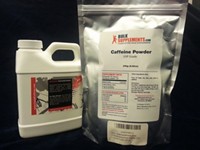Advertisement
Grab your lab coat. Let's get started
Welcome!
Welcome!
Create an account below to get 6 C&EN articles per month, receive newsletters and more - all free.
It seems this is your first time logging in online. Please enter the following information to continue.
As an ACS member you automatically get access to this site. All we need is few more details to create your reading experience.
Not you? Sign in with a different account.
Not you? Sign in with a different account.
ERROR 1
ERROR 1
ERROR 2
ERROR 2
ERROR 2
ERROR 2
ERROR 2
Password and Confirm password must match.
If you have an ACS member number, please enter it here so we can link this account to your membership. (optional)
ERROR 2
ACS values your privacy. By submitting your information, you are gaining access to C&EN and subscribing to our weekly newsletter. We use the information you provide to make your reading experience better, and we will never sell your data to third party members.
Environment
Not High On Coke
March 26, 2012
| A version of this story appeared in
Volume 90, Issue 13
Jan. 30, pages 57 and 90, and March 5, page 61: Kimberly Prather is a professor at the University of California, San Diego, not UC Davis.
March 5, page 55: Ute Deichmann is a she not a he, as stated in the article.
The efforts of Coca-Cola to improve its public image by packaging its beverages in a completely plant-derived polyethylene terephthalate bottle were described in a recent issue (C&EN, Jan. 23, page 19).
The company uses about 100 billion single-use throwaway bottles per year. This consumes an excessive amount of material and energy and contributes to global warming. (This is one reason that the U.S. leads the world in waste per capita and energy use per capita.) Only 16% of PET is recycled. The process is complicated by a label, cap, and cap liner made of other plastics. Fifty years ago a 6-oz glass bottle cost five cents, of which two cents was returned to the customer when the bottle was returned. The bottle lasted about 13 trips before it had to be recycled, making the cost per use lower than that of a single-use bottle.
Coke is a 10–12% aqueous solution of sugars (usually high-fructose corn syrup), phosphoric acid, caffeine, caramel coloring, flavor, and sodium benzoate (a preservative) under the pressure of carbon dioxide. It contains no vitamins, minerals, polysaccharides, lipids, or proteins. Its regular consumption can lead to dental caries and excess weight. (About 68% of Americans are overweight or obese.)
The nutritional guidelines of the Institute of Medicine and the Department of Agriculture suggest a maximum daily consumption of 37 g of sugar for a male and 25 g for a female. Drinking a 20-oz bottle of Coke can easily push one over these limits. The company has also been criticized for its efforts in developing countries to displace nutritious local fruit drinks with Coke.
The effects of sugary drinks on tooth enamel are described on page 48 of the same issue of C&EN.
By Albert S. Matlack
Hockessin, Del.




Join the conversation
Contact the reporter
Submit a Letter to the Editor for publication
Engage with us on Twitter